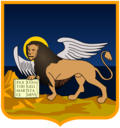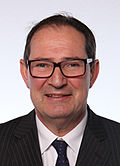Regional Council of Veneto Consiglio Regionale del Veneto | |
|---|---|
| 12th Legislature | |
 | |
| Type | |
| Type | |
| Established | 6 July 1970 |
| Leadership | |
President | |
| Structure | |
| Seats | 51 |
 | |
Political groups | Government (34) Opposition (17) |
Length of term | 5 years |
| Elections | |
| Party-list semi-proportional representation with majority bonus D'Hondt method | |
Last election | 23 November 2025 |
| Meeting place | |
 | |
| Palazzo Ferro Fini, Venice | |
| Website | |
| http://www.consiglioveneto.it | |
 |
|---|
|
The Regional Council of Veneto (Italian : Consiglio Regionale del Veneto) is the legislative assembly of Veneto, Italy.
Contents
- Composition
- Political groups (2025–2030)
- Historical composition
- Presidents
- See also
- References
- External links
The council, which has its seat at Palazzo Ferro Fini, located along the Grand Canal in Venice. [1] was first elected in 1970, when ordinary regions were established, twenty-two years after the Italian Constitution envisioned them in 1948.









